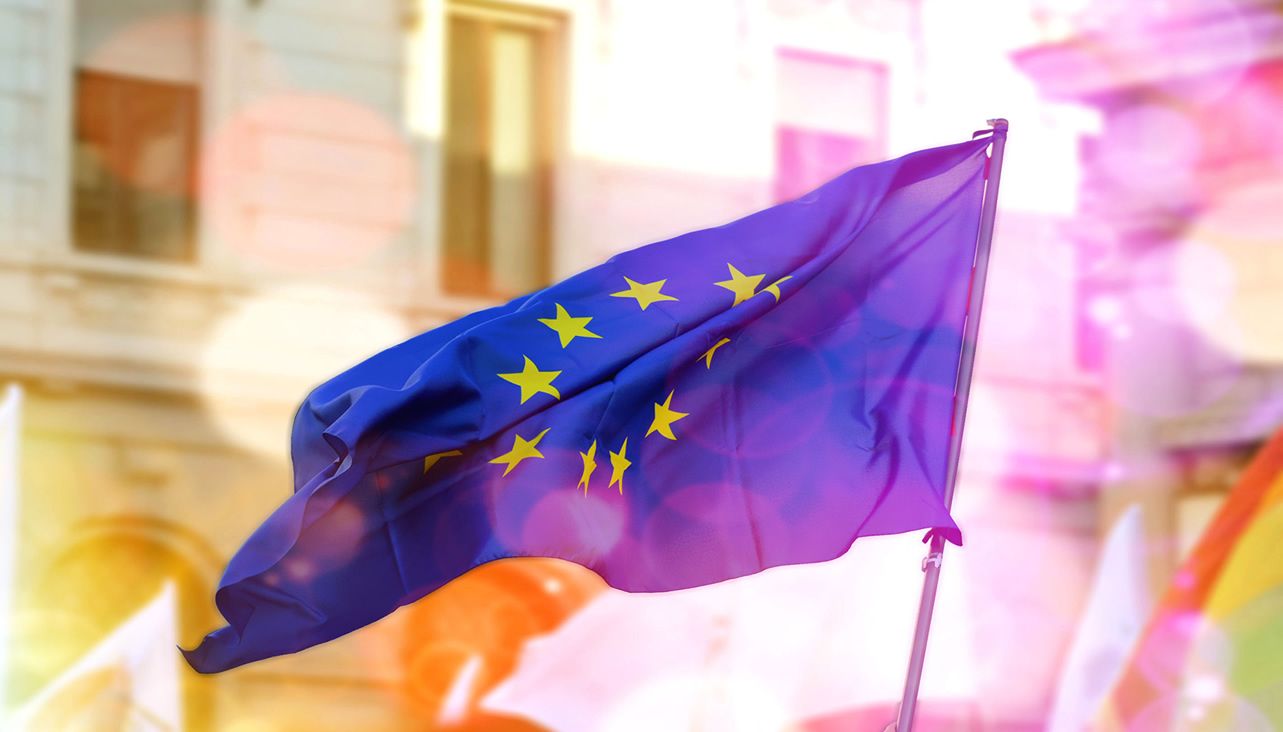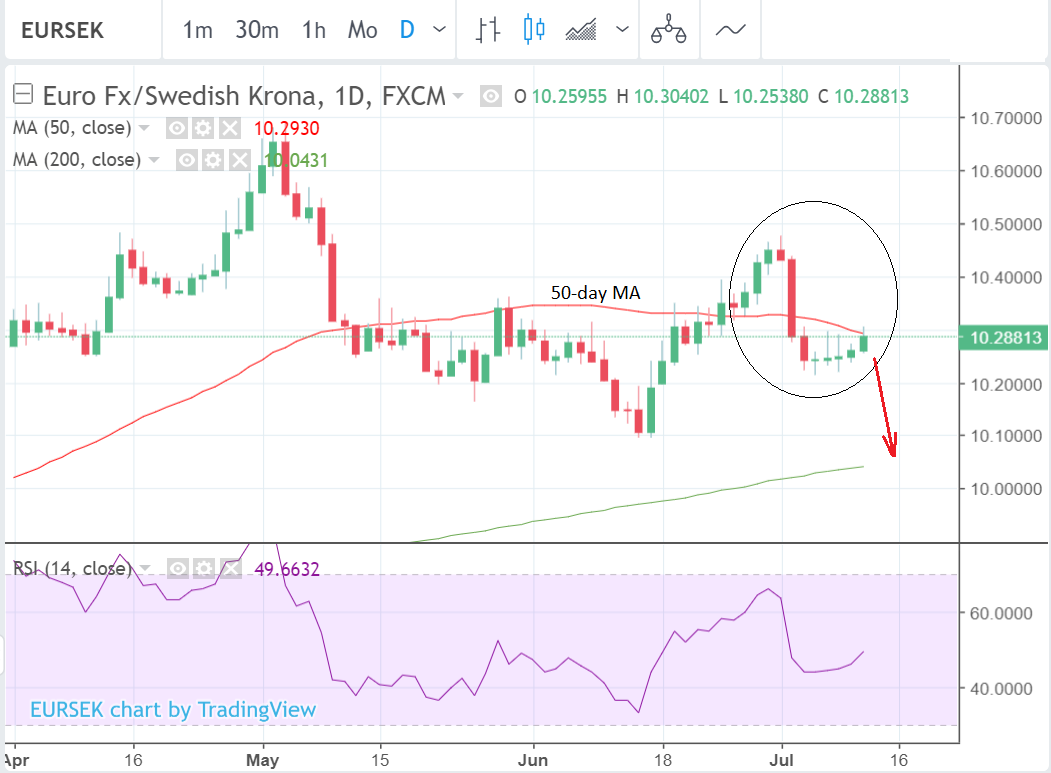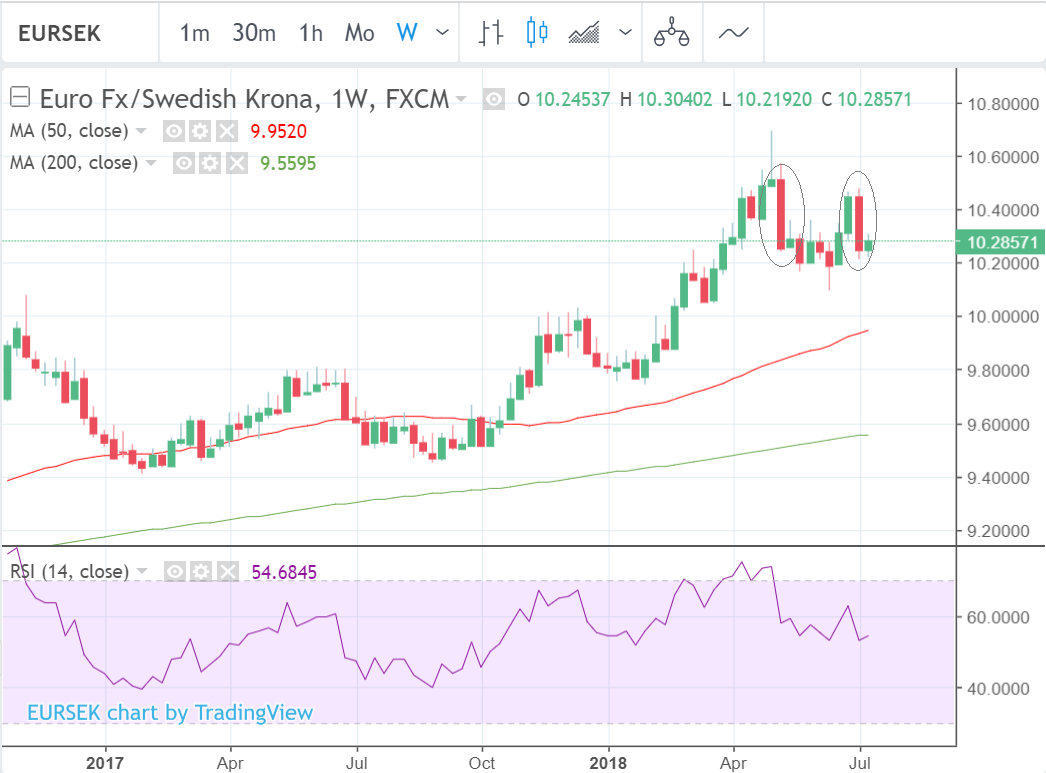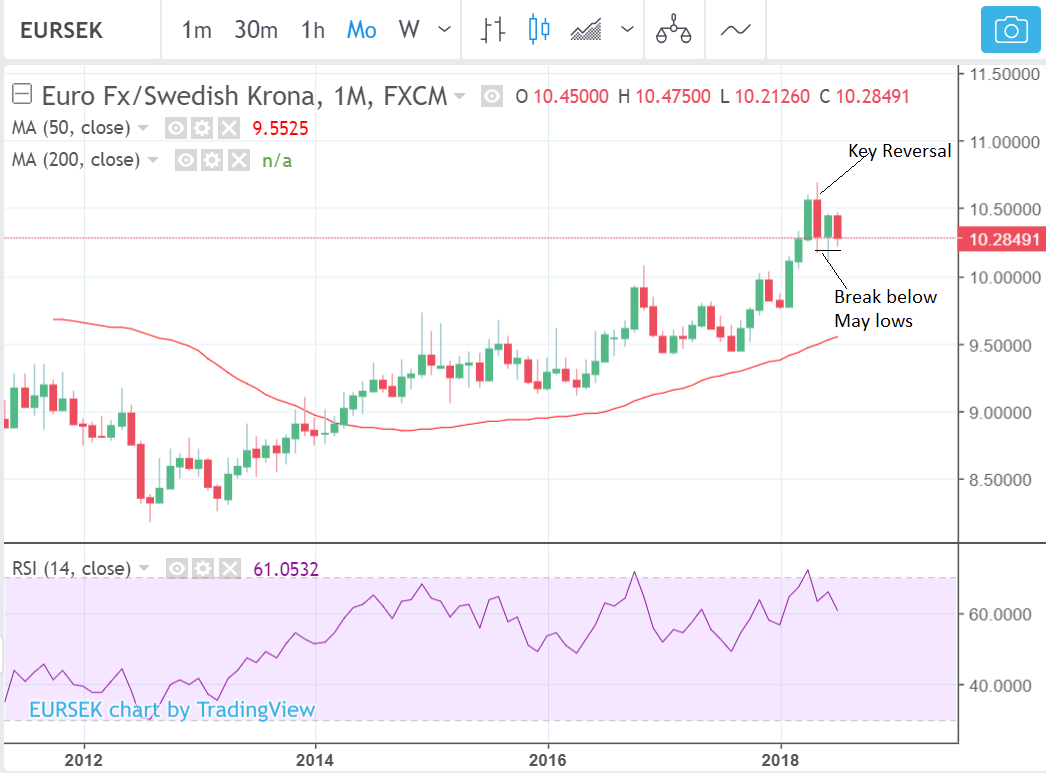EUR/SEK Charts Point to Steep Losses, Reuters Poll Corroborates
- Bearish charts suggest downside on horizon for EUR/SEK.
- Daily, weekly and monthly charts are all moderately bearish.
- Reuters poll and Danske Bank analysis corroborate bearish outlook.

© Lisa L, Adobe Stock
Sweden's currency may fare better then its football team during the coming weeks if analysts are to be believed and the charts don't lie.
The Euro-to-Swedish-Krona (EUR/SEK) rate is looking especially bearish from a technical perspective but added to this is growing fundamental evidence, including results from a recent Reuters poll, which point to more downside for the pair.
Looking at the charts, the daily chart shows prices recently meeting resistance from the formidable 50-day moving average (MA). The 50-day average is likely to present an extremely tough ceiling for bulls to break through given that prices tend to choose the path of least resistance, a fall is a more likely outcome.

Above: EUR/SEK rate shown at daily intervals.
The recent sideways move was preceded by a steep descent from the July 2 highs at 10.4750, to lows of 10.2126, established on 05 July.
The 'L' shape produced (circled) by this move is usually a bearish indicator as markets generally continue in the direction of greater volatility, which in this case is down. Another leg lower would be the most natural outcome, therefore, probably to the next 'natural' stopping place (to maintain price-action 'symmetry') at the level of the 200-day MA at around 10.04.
The two large down weeks circled on the weekly chart below also suggest that a strong possibility of a bearish reversal of the medium-term uptrend is in the offing. Momentum as measured by the relative-strength-index (RSI) is also looking rather weak.
Above: EUR/SEK rate shown at weekly intervals.
Finally, on the monthly chart there was a bearish key reversal at the May highs, nicely punctuating what is probably the end of a long-term uptrend and then a three-month reversal after the market broke below the May lows back in June.

Above: EUR/SEK rate shown at monthly intervals.
Note too how the two peaks in momentum occurred at almost the same level even though the exchange rate was much higher at the second peak back in May. This is something analysts call 'divergence' and although it is only moderate in this case, it is still a bearish indicator.
The RSI momentum indicator in the lower panel has also formed a common pattern called a double top, which looks like the letter 'M' and is often present at market highs before they reverse into a downtrend. Double tops can appear both in general price action as well as on indicators. They work just as well on the latter.
If the RSI breaks below the trough at the base of the pattern (the neckline) around 49.49, it will be a signal to sell in a big way. The pattern would then indicate momentum sliding about 23 points to an RSI level of 26, based on the observation that double tops fall the same distance as they previously rose.
From a fundamental perspective it is perhaps hard to square the bearish charts with a commonly-held positive view of the Euro. Yet one source of potential strength for the Krona could be the perception that interest rates in Sweden have massive scope to rise, due to their extremely low current levels, as has been suggested by the Riksbank.
The base interest rate stands at -0.50% in Sweden, which is even lower than the already mega-low 0.0% in the Eurozone. Sweden's rate is the second lowest in the world after Switzerland but analysts are now expect that it will rise after inflation in Sweden reached the Riksbank's 2.0% target this year. Expectations are now for a rate hike of 0.25% by year-end.
Higher interest rates appreciate currencies by increasing inflows of foreign capital drawn by the promise of higher returns, so a rise in Q4 would support the Krona. The ECB in comparison is not expected to raise interest rates in Europe until August or September 2019.
This suggests Sweden will close the gap between the two interest rates, which could drive a return to 'equilibrium' for the currency pair. Analysts at Danske Bank were positive about the most recent communication from the Riksbank's meeting ending on July 3.
“In the near term, expectations of a Q4 rate hike will probably be kept alive and as such lend some support to the SEK. The Riksbank adjusted its KIX forecast in a very traditional way, meaning that it still assumes that the krona will appreciate over the forecast horizon. In particular, the KIX forecast indicates it assumes a 3.3% SEK appreciation until Q4 (116.1), which would correspond to EUR/SEK moving to 10.10, all else being equal," the Danske team says, in a note to clients. “We expect EUR/SEK to continue to edge lower toward 10.20 in the coming weeks, a potential buying opportunity if we are right on the Riksbank delaying the first hike”.
Further support for a bullish SEK comes from a Reuters poll conducted at the start of July which sees the majority of experts forecasting the currency to appreciate versus the Euro.
"The Swedish and Norwegian currencies are set to strengthen against the euro over the next year, boosted by strong economies and higher interest rates, a Reuters poll forecast on Friday," writes Simon Johnson, a reporter at Reuters.
"Both nations have seen their currencies slide over the last six years, reflecting ultra-loose monetary policy, housing market problems and in Norway's case, lower oil prices."
Johnson also notes how analysts have been flagging the Norwegian and Swedish currencies as being undervalued for some time now, given their interest rates are super low at a time when both economies are growing strongly.
Advertisement
Get up to 5% more foreign exchange by using a specialist provider to get closer to the real market rate and avoid the gaping spreads charged by your bank when providing currency. Learn more here
